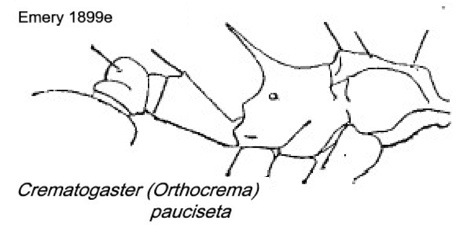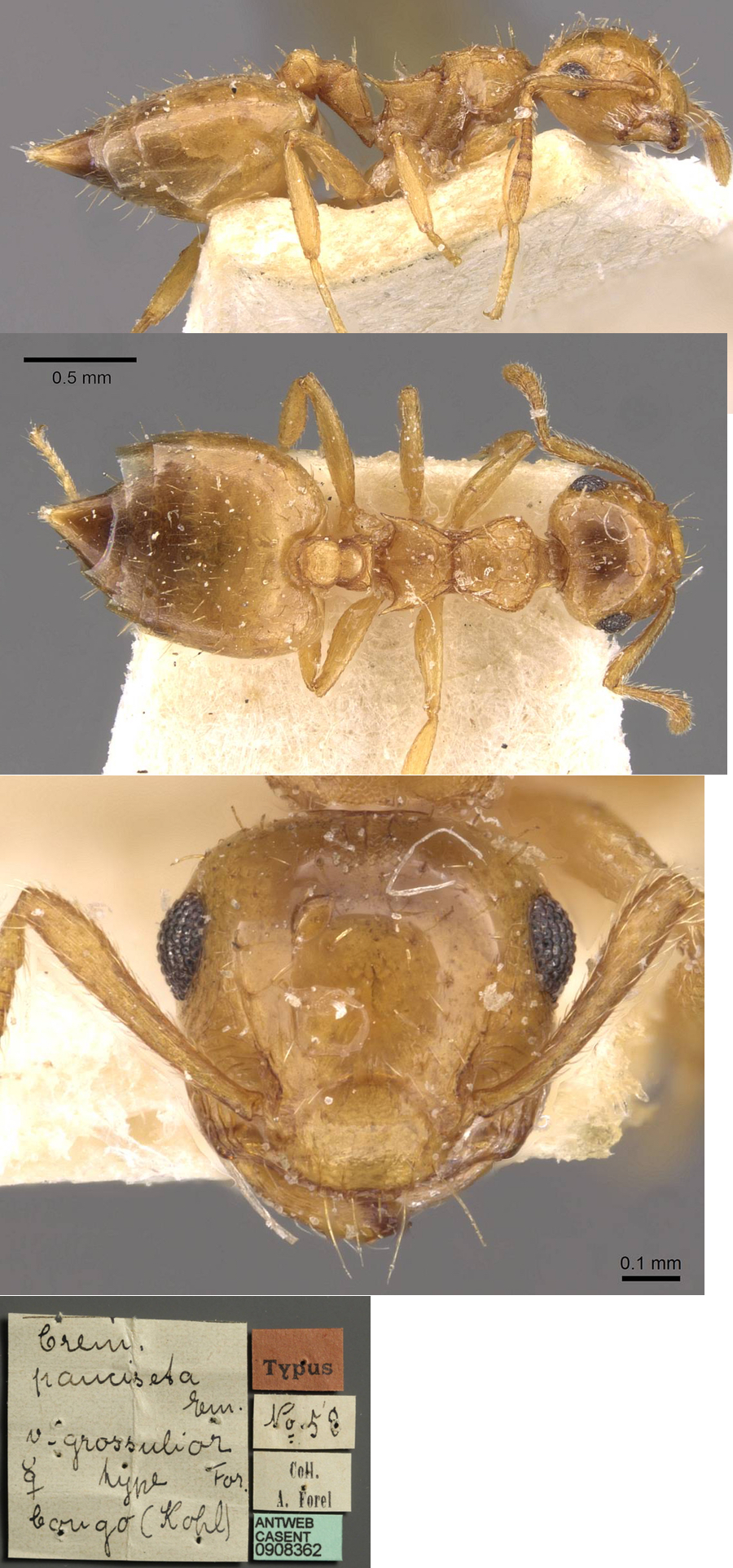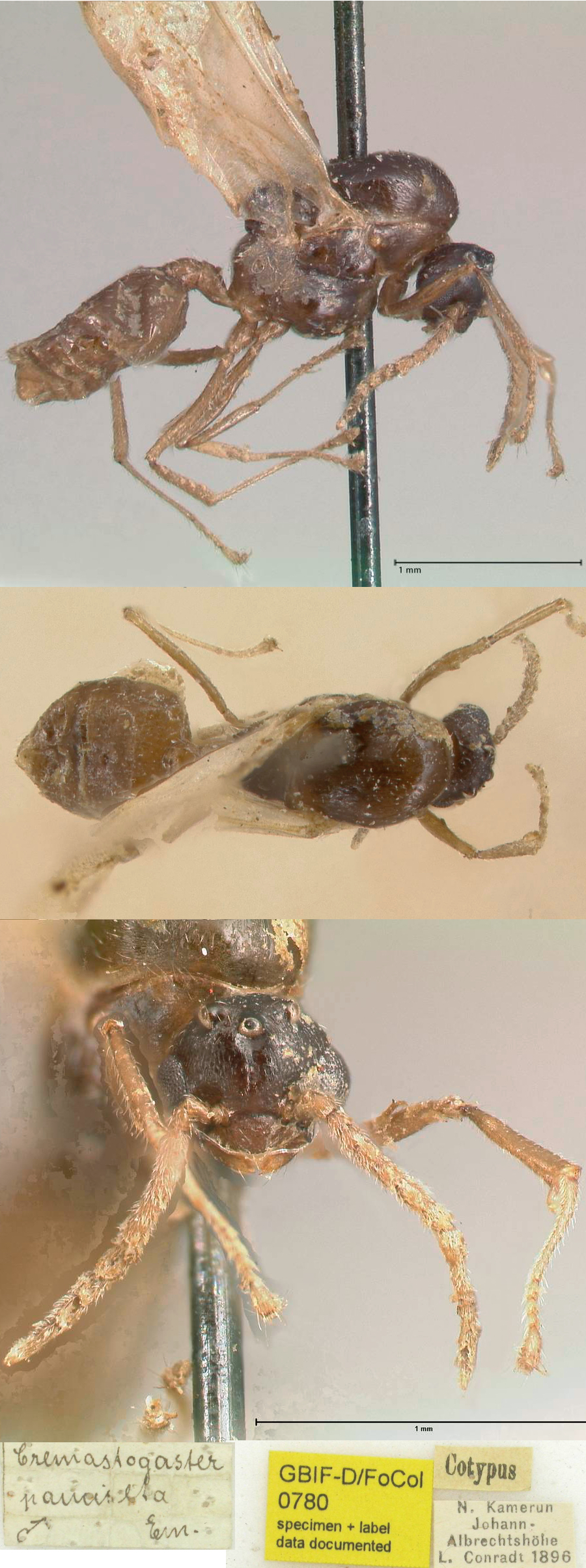Crematogaster (Orthocrema) pauciseta Emery
  Type location Cameroun (Crematogaster pauciseta n. sp.,
Emery,
1899e: 485, illustrated, worker & queen; Forel, 1913e: 669, male)
collector Conradt -
see below Type location Cameroun (Crematogaster pauciseta n. sp.,
Emery,
1899e: 485, illustrated, worker & queen; Forel, 1913e: 669, male)
collector Conradt -
see below
junior synonyms (here)
grossulior (Cremastogaster
pauciseta Em. r. grossulior
n. stirps, Forel, 1916:
404, worker) from Zaïre, St
Gabriel, Kohl -
see below
pulchella (Crematogaster
(Orthocrema) pulchella n. sp., Bernard, 1952: 230, illustrated,
worker & queen) type location Guinea,
Mt Nimba - see below.
All forms described (see Bolton, 1995)  . .
|
 Emery's
(1899e) description is at Emery's
(1899e) description is at  . Forel's (1916) description of grossulior
is at . Forel's (1916) description of grossulior
is at  . .
Forel (1913e) reported the collection of the worker,
queen and male by Conradt, from Cameroun, and that he could not say
that the small brown male, with hyaline wings, TL 3.0 mm, was of the
species.
Wheeler (1922) also had pauciseta from
Kilalonga, near St Gabriel, Zaïre, by Kohl; reported by Forel
(1915c) as on nectaries of an Acacia
(place spelt Kilongalonga).
Bernard (1952) examined the type specimens, including
queens, in Forel's collection (in Paris).
TL > 2.5 mm; colour of head and thorax yellow-orange,
gaster clear brown, sometimes yellowish anteriorly. Compared with pulchella
- antennal funiculus more slender and segment 2 twice as long as wide,
following segments 1.5 times as long as wide; petiole similar but
gaster flatter and less voluminous than the thorax, finely reticulated
and only slightly shiny (after Bernard, 1952, in his notes on pulchella).
|
 The
photomontage of the holotype worker is
collated from http://www.antweb.org/specimen.do?name=casent0904490. The
photomontage of the holotype worker is
collated from http://www.antweb.org/specimen.do?name=casent0904490.
|
 The
photomontage of the grossulior
type
worker is
collated from http://www.antweb.org/specimen.do?name=casent0908362. The
photomontage of the grossulior
type
worker is
collated from http://www.antweb.org/specimen.do?name=casent0908362.
|
 The
photomontage of the probable male is collated from http://www.antweb.org/specimen.do?name=focol0780. The
photomontage of the probable male is collated from http://www.antweb.org/specimen.do?name=focol0780.
|
|
Oxford University Museum
specimens
Crematogaster (Orthocrema) pauciseta
B Taylor det.
|
Cameroun
A Fotso Kuate
Crematogaster sp14
|
17.vii.2007
Awae II
03°54'30" N
11°25'58" E
|
Quadrat in fallow
|
2
|
 |
Crematogaster (Orthocrema) pauciseta
B Taylor det.
|
Cameroun
G Debout & A Dalecky
Cameroon 118
|
18.iv.2001
Kouedjina
3°55' N
13°45' E
|
.
|
2
|
 |
Crematogaster (Orthocrema) pauciseta
B Taylor det.
Queen
|
Central African
Republic
P Annoyer
NS
|
24.xi.2010
Dzanga-Sangha
2°28'49.5"N
16°12'55.9"E
|
392 m; nuit : 18h -
6h, UV, Azobée, sol, camp de base lac 1
|
1
|
 |
|
 The
photomontage is of a worker from Cameroun;
Awae II; collector A Fotso Kuate (fk crematogaster sp14). The
photomontage is of a worker from Cameroun;
Awae II; collector A Fotso Kuate (fk crematogaster sp14).
|
 The
photomontage is of a probable queen from Central African Republic;
Dzanga-Sangha; collector Philippe Annoyer (CAR NS). The
photomontage is of a probable queen from Central African Republic;
Dzanga-Sangha; collector Philippe Annoyer (CAR NS).
|
| Crematogaster (Orthocrema) pulchella Bernard
Type location Guinea
(Bernard, 1952: 230, illustrated, worker & queen). Collected at Mt.
Nimba; 6 workers from forest at Mount Tô; 10 workers (also many cotypes
in alcohol), 1 dealated queen and 1 ergatoid female from same, ravine
1, station B2.41; 4 workers from scrub on the crest of Nion (Lamotte) -
see below
|
 Bernard's
(1952) description is at Bernard's
(1952) description is at  . .
TL 2.3-2.5 mm; head, thorax and petiole shiny clear
yellow, with few hairs. Head sometimes a little browner, small and
rounded; antennal scape short, second segment of funiculus just ¼
longer than wide, segments 4-6 twice as long as wide. Petiole longer
than wide, clear yellow, slighty dilated and angular anteriorly. Gaster
voluminous, clearly cordiform, entirely pure black, very shiny and not
reticulated (after Bernard, 1952).
Bernard (1952) remarked how the workers were similar to
those of pauciseta but the queens differ strongly, most closely
resembling Crem. natalensis (from South Africa) (having
examined the type specimens in Forel's collection, in Paris); and
sharing the unusual ergatoid female morph. There were distinct
differences between the queens of pulchella and natalensis.
The ergatoid of pulchella was about twice the size of the
worker but otherwise similar in colour, etc.
Clypeus large and slightly convex, no frontal triangle.
The dorsal alitrunk has very distinct sculpturation with three
longitudinal carinae - the lateral carinae extending back at the
metanotal groove to produce pseudospines. The metanotal declivity is
vertical dropping to a right angle with the propodeum. The latter has a
flat dorsum on a much lower level than the promesonotum. Propodeal
spines long, sharp and slightly upturned. The propodeal spiracle is set
distinctly removed from the base of the spines and is rearward facing
with a sclerotised rim. Lateral petiole thick and spiculate;
postpetiole also spiculate. Pronotal angles each with a distinctive
long thick erect hair. All of the very few erect hairs are long and
slightly spatulate.
|
 The
photomontage of the holotype worker is
collated from http://www.antweb.org/specimen.do?name=casent0913653. The
photomontage of the holotype worker is
collated from http://www.antweb.org/specimen.do?name=casent0913653.
|
Oxford University Museum
specimens
Crematogaster (Orthocrema) pulchella
B Taylor det.
|
Cameroun
G Debout & A Dalecky
Cameroon 118
|
18.iv.2001
Kouedjina
3°55' N
13°45' E
|
.
|
2
|
 |
|
 The
photomontage is of specimens collected
in Cameroun - Cameroon 118, 15.ii.2001, Kouedjina (3°55' N,
13°45' E, altitude 692 m), extreme south-east (McKey Wolbachia
project). The
photomontage is of specimens collected
in Cameroun - Cameroon 118, 15.ii.2001, Kouedjina (3°55' N,
13°45' E, altitude 692 m), extreme south-east (McKey Wolbachia
project).
|
|